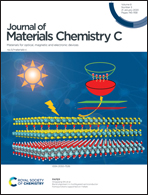Band structure engineering in Sn1.03Te through an In-induced resonant level†
Abstract
Narrow-band-gap IV–VI semiconductors represent a historically important class of thermoelectric materials. As one of the representative compounds of this class, SnTe has been reinvestigated over the last few years demonstrating its potential as a high-temperature p-type thermoelectric material. Here, we present a detailed study of the influence of very low doping levels of In, from 0.05% up to 2%, on the high-temperature transport properties of the self-compensated Sn1.03Te compound. Our results evidence a strong impact of In on the transport properties, consistent with the presence of an In-induced resonant level (RL) in the valence bands of Sn1.03Te. This peculiar behavior is confirmed by electronic band structure calculations performed using the Korringa–Kohn–Rostoker method with the coherent potential approximation (KKR-CPA) revealing a narrow and sharp peak in the density of states (DOS) induced by the hybridization of the In s-states with the electronic states of Sn1.03Te. This distortion in the DOS results in a spectacular increase in both the thermopower and electrical resistivity at 300 K. Although the influence of the RL is somewhat lessened at higher temperatures, a significant enhancement in the ZT values is nevertheless achieved with a peak ZT of 0.75 at 800 K which represents an increase of 35% over the values measured in Sn1.03Te. Of relevance for practical applications, the weak dependence of the RL on temperature leads to an enhanced average ZT value.



 Please wait while we load your content...
Please wait while we load your content...